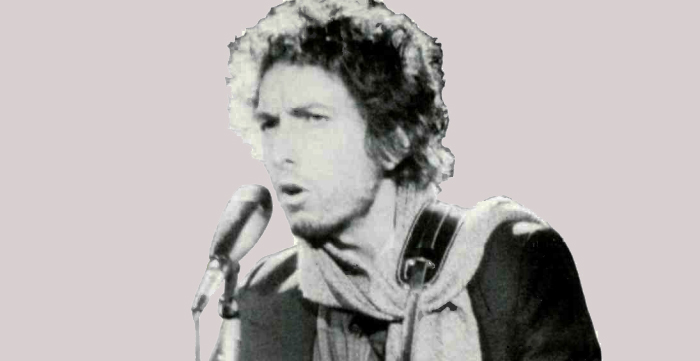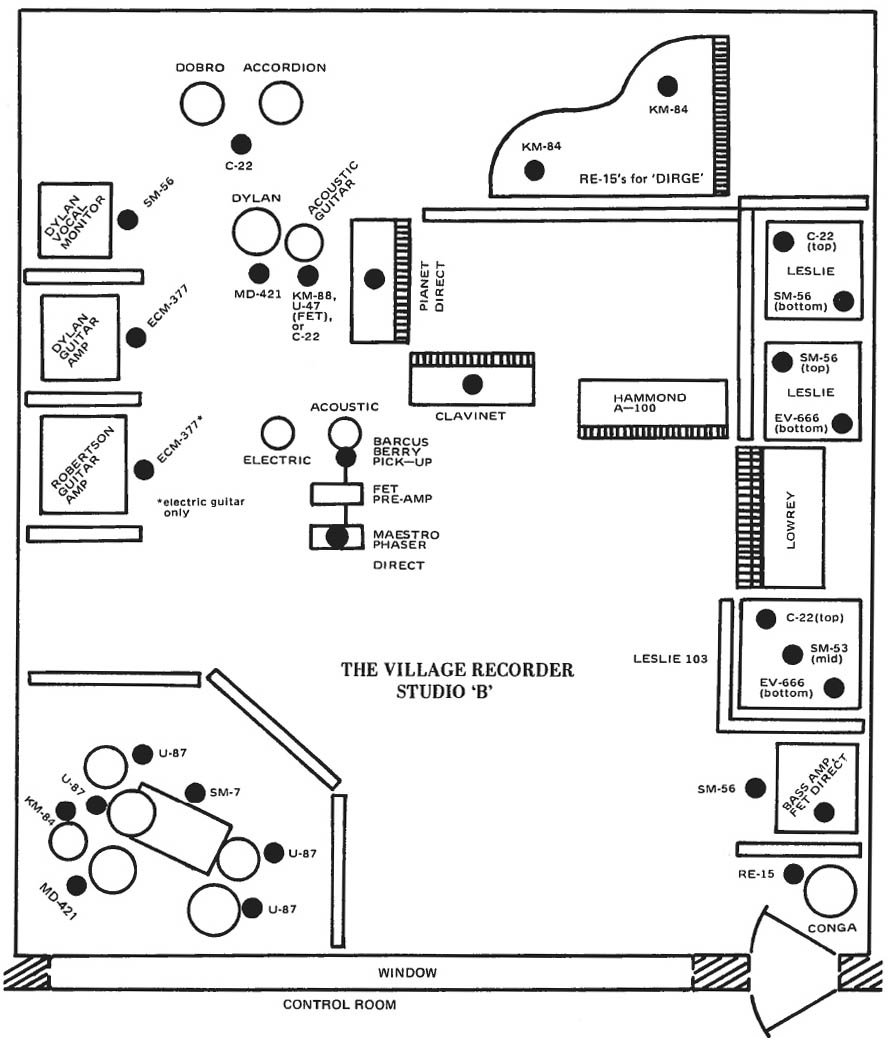
R-e/p: Let’s run through the rest of the miking. The diagram you prepared shows a lot. What about the choice of piano mikes?
RF: We used two KM 84’s. I tried a couple of things. I miked both facing the hinge. One of them was almost to the end of the harp, and about 12 inches toward the hammers about a foot to 18 inches from the hinge. The body of the mike was parallel to the soundboard, about 2 inches up.
The other mike was in the same basic position, but angled a bit toward the soundboard 00 about 30 degrees. It was in the high end section of the piano, nearer the holes. It worked really well, with practically no leakage at all.
R-e/p: Did you have the top open?
RF: I had it on the short peg, with it really covered. We were all surprised how low the leakage was. But when I did ‘Dirge’ with Bob, we used a completely different set up, mainly because he wanted it that way. I had it open all the way, no covers, nothing.
R-e/p: Did the piano get into his vocal?
RF: No, he sings so loud. Interestingly enough, the one thing that leaked into the drums was Bob’s vocal. That’s one reason the leakage was so low. He really sings hard. In fact, he was leaking so badly into the uncovered piano that I had to experiment.
I used RE15’s. I faced them toward the back of the piano, instead of the hammers, and it worked really well. It took a bit of EQ, but as far as leakage went, it was really excellent. Plus, as I said, he wanted a more “far away” sound for that number.
R-e/p: Were there any other unusual or special miking techniques?
RF: Let’s see. We used a special direct box for the bass. Our maintenance man, Ken Klinger, built it. It’s a solid state, discrete, FET type. We used that on the bass, and miked the amp—a twin reverb, I think with a 56.
R-e/p: It’s becoming easier to see where all the mikes were used. According to the diagram, there seem to be quite a few more instruments than there were players. Were they all used in the same session?
RF: Yes, sometimes. There was a pianet and clavinet—both were direct. Rick (Danko), who played bass, also played fiddle a bit. And there was an accordion. There was also a Dobro guitar. I had extra mikes up for these instruments, for whatever might happen. The Band didn’t do any singing on the album. And that’s it.
R-e/p: With all the close miking and the experienced musicians, did the actual levels in the studio tend to be low? And, if so, did everybody wear phones?
RF: The levels were medium-loud, and they could hear each other in the room. They would occasionally wear phones.
R-e/p: What kind of mixes would you give them? Heavy on their own instruments, just the other guys, or what?
RF: A stereo mix of the whole thing, and they loved it. They had Sennheiser 414 phones, and the stereo worked out very well, especially for Garth. I could put one Leslie in one ear, and the other Leslie in the other ear, and it gave him the perfect effect because that’s what he does. He puts the Leslies on either side of the Lowrey so that when he uses the different keyboards, the sound goes back and forth.
R-e/p: As far as your monitoring was concerned, did you listen in mono at all?
RF: Yes, a lot. That’s a sure-fire way to acoustically catch phase problems.
R-e/p: But what do you do with something like the Leslie, where the phase is all over the place?
RF: That’s a whole different circumstance. You just do your best to make it sound good.
Editor’s Note: This is a series of articles from Recording Engineer/Producer (RE/P) magazine, which began publishing in 1970 under the direction of Publisher/Editor Martin Gallay. After a great run, RE/P ceased publishing in the early 1990s, yet its content is still much revered in the professional audio community. RE/P also published the first issues of Live Sound International magazine as a quarterly supplement, beginning in the late 1980s, and LSI grew to become the monthly publication that continues to thrive to this day.
Our sincere thanks to Mark Gander of JBL Professional for his considerable support on this archive project.

